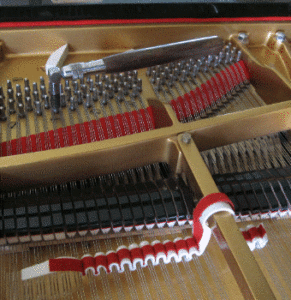A single piano key sets into motion a set of 3 strings, all set in motion by the same hammer and all tuned, ideally, to the exact same pitch. This collection of 3 strings is called a unison. One usually sets a temperment by muting off 2 of the 3 strings in each unison over the temperment octave. This allows you to really focus on specific individual partials between the note you are tuning and the note you are tuning from. This is usually done by threading a thick felt strip between each of the unisons, muting the outside string of each. You then tune the center string as the reference. Setting a temperment is a really process of adjusting 12 variables, each of the strings in the octave. making those fine adjustments is considered much easier to do with one string at a time, and then, when you are satisfied, you tune each of the other strings (left and right) to the center one.
Now, there are different techniques. One way is to mute off the entire piano, listening to a total of 2 strings at a time. But as with a lot of things, less is often considered more. The macho tuner claims to use 1, or maybe 2 individual mutes. The implication and reality is that that tuner is so sure of where that single string is set, that he can tune the other 2 to it and be confident that he won’t need to come back and adjust it slightly later. It sounds like hubris but when you see it done by the right person, you come away thinking that there was no other position for any of the strings, that that person set them exactly where they were meant to be.
This assumes a very high skill level and a piano that is extremely well tuned to begin with. But it also compliments the notion that very high level tuning takes into account all 3 strings of any unison as an integral part of the overall sound of that piano. By muting off you’re taking out of consideration a key part of resulting piano sound so how could your tuning possibly be optimized?
All it takes is practice.
